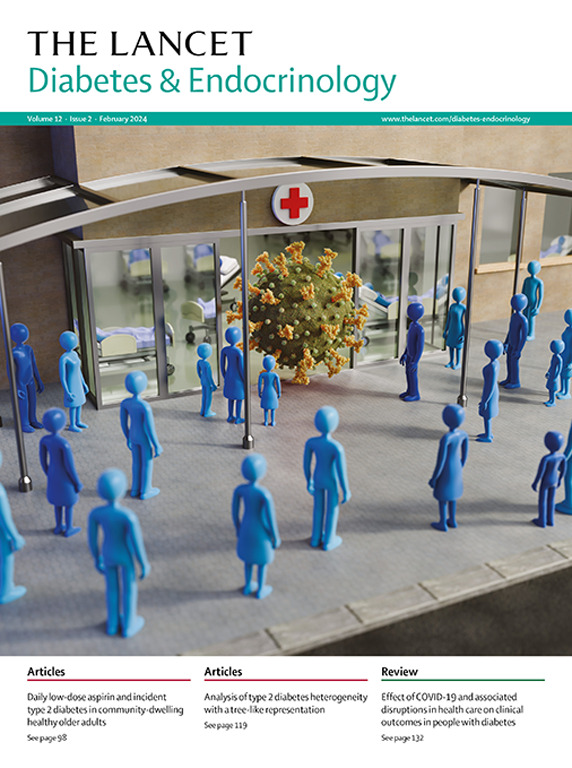GLP-1 receptor agonists in kidney transplant recipients with pre-existing diabetes: a retrospective cohort study
IF 44
1区 医学
Q1 ENDOCRINOLOGY & METABOLISM
引用次数: 0
Abstract
Background
Given the cardiovascular, renal, and survival benefits of GLP-1 receptor agonists for diabetes, these agents could be effective among kidney transplant recipients. However, kidney transplant recipients are distinct from GLP-1 receptor agonist trial participants, with longer diabetes duration and severity, greater end-organ damage, increased cardiovascular risk, and multimorbidity. We examined GLP-1 receptor agonist real-world effectiveness and safety in kidney transplant recipients with diabetes.Methods
This USA-based retrospective cohort study included kidney transplant recipients with type 2 diabetes at transplantation and Medicare as their primary insurance from a national registry linked with Medicare claims. Post-transplantation GLP-1 receptor agonist use was identified through Medicare claims. Death-censored graft loss was estimated using the Fine-Gray sub-distribution hazard model and extended Cox models were used for mortality and safety endpoints. Models incorporated inverse probability of treatment weights. To further test whether bias could affect the main results, a cohort was created in which each GLP-1 receptor agonist user was matched with a kidney transplant recipient who had not started a GLP-1 receptor agonist, was alive with a functioning graft, and had accrued the same amount of post-transplant survival time.Findings
Between Jan 1, 2013 and Dec 31, 2020, we identified 44 536 first time kidney transplant recipients with Medicare as primary payer in the 6 months before and at transplantation. 24 192 patients were excluded as they did not have type 2 diabetes. 2328 patients were ineligible (1916 had missing values and 412 used GLP-1 receptor agonists before transplantation). The primary cohort thus consisted of 18 016 kidney transplant recipients with diabetes. Of these patients, 1969 (10·9%) had at least one GLP-1 receptor agonist prescription filled post-transplant. Compared with patients who had not received a GLP-1 receptor agonist, GLP-1 receptor agonist users were younger (median age at transplant 57 years [IQR 49–64] vs 60 years [51–66], p<0·0001) and more likely to be female (786 [39·9%] vs 5645 [35·2%], p<0·0001). Among GLP-1 receptor agonist users, 552 [28·0%] were non-Hispanic White, 703 [35·7%] were non-Hispanic Black, and 568 [28·8%] were Hispanic. The 5-year unadjusted cumulative incidence of death-censored graft loss from a cohort matched on survival time before GLP-1 receptor agonist initiation was 6·0% for GLP-1 receptor agonist users and 10·7% for non-users (Gray's test p=0·004). The 5-year unadjusted cumulative incidence for mortality from a cohort matched on survival time before GLP-1 receptor agonist initiation was 17·0% for GLP-1 receptor agonist users and 25·8% for non-users (log-rank p=0·0006). The 5-year unadjusted cumulative incidence for mortality was 13·5% for GLP-1 receptor agonist users and 19·9% for non-users (log-rank p<0·0001). GLP-1 receptor agonist use was associated with a 49% lower incidence of death-censored graft loss (adjusted subhazard ratio [aSHR] 0·51, 95% CI 0·36–0·71; p=0·0001) and 31% lower mortality (adjusted hazard ratio [aHR] 0·69, 95% CI 0·55–0·86; p=0·001). Inferences were robust when matched on survival time (death-censored graft loss aSHR 0·53, 95% CI 0·37–0·75; p=0·0005; mortality aHR 0·70, 95% CI 0·55–0·88; p=0·003). Safety endpoints were rare and not associated with GLP-1 receptor agonists, with the exception of diabetic retinopathy (aHR 1·49, 1·11–2·00; p=0·008).Interpretation
GLP-1 receptor agonists were associated with better graft and patient survival. Clinical trials are needed to confirm these findings.Funding
National Institutes of Health.GLP-1受体激动剂在既往糖尿病肾移植受者中的应用:一项回顾性队列研究
背景鉴于 GLP-1 受体激动剂对糖尿病患者的心血管、肾脏和存活有好处,这些药物对肾移植受者可能有效。然而,肾移植受者与 GLP-1 受体激动剂试验参与者不同,他们的糖尿病病程更长、病情更严重、终末器官损伤更大、心血管风险更高,而且患有多种疾病。我们研究了 GLP-1 受体激动剂在糖尿病肾移植受者中的实际有效性和安全性。方法这项以美国为基地的回顾性队列研究纳入了肾移植受者,他们在移植时患有 2 型糖尿病,医疗保险是他们的主要保险,这些受者来自与医疗保险索赔相关联的国家登记处。移植后 GLP-1 受体激动剂的使用情况通过医疗保险报销单进行确认。使用Fine-Gray亚分布危险模型估算以死亡为剪切值的移植物损失,并使用扩展的Cox模型计算死亡率和安全性终点。模型纳入了治疗的逆概率权重。为了进一步检验偏差是否会影响主要结果,我们创建了一个队列,其中每个 GLP-1 受体激动剂使用者都与未开始使用 GLP-1 受体激动剂的肾移植受者相匹配,后者存活且移植物功能正常,并积累了相同数量的移植后存活时间。24 192 例患者因未患有 2 型糖尿病而被排除在外。2328 名患者不符合条件(1916 名患者数值缺失,412 名患者在移植前使用过 GLP-1 受体激动剂)。因此,主要队列由 18 016 名患有糖尿病的肾移植受者组成。在这些患者中,1969 人(10-9%)在移植后至少服用过一次 GLP-1 受体激动剂。与未接受 GLP-1 受体激动剂治疗的患者相比,GLP-1 受体激动剂使用者更年轻(移植时的中位年龄为 57 岁 [IQR 49-64] vs 60 岁 [51-66],p<0-0001),更可能是女性(786 [39-9%] vs 5645 [35-2%],p<0-0001)。在 GLP-1 受体激动剂使用者中,552 人[28-0%]为非西班牙裔白人,703 人[35-7%]为非西班牙裔黑人,568 人[28-8%]为西班牙裔。根据开始使用 GLP-1 受体激动剂前的存活时间匹配队列,使用 GLP-1 受体激动剂的 5 年未调整累积死亡剪除移植物丢失发生率为 6-0%,未使用的为 10-7%(格雷氏检验 p=0-004)。根据开始使用 GLP-1 受体激动剂前的存活时间进行匹配的队列中,GLP-1 受体激动剂使用者的 5 年未调整累积死亡率为 17-0%,非使用者为 25-8%(对数秩检验 p=0-0006)。GLP-1受体激动剂使用者的5年未调整累积死亡率为13-5%,非使用者为19-9%(对数秩p<0-0001)。使用 GLP-1 受体激动剂与死亡剪除移植物丢失发生率降低 49% 相关(调整亚危险比 [aSHR] 0-51,95% CI 0-36-0-71;p=0-0001),与死亡率降低 31% 相关(调整危险比 [aHR] 0-69,95% CI 0-55-0-86;p=0-001)。如果与生存时间相匹配,推论也是可靠的(死亡剪除移植物丢失 aSHR 0-53,95% CI 0-37-0-75;p=0-0005;死亡率 aHR 0-70,95% CI 0-55-0-88;p=0-003)。除糖尿病视网膜病变(aHR 1-49,1-11-2-00;p=0-008)外,安全性终点很少出现,且与 GLP-1 受体激动剂无关。需要进行临床试验来证实这些发现。
本文章由计算机程序翻译,如有差异,请以英文原文为准。
求助全文
约1分钟内获得全文
求助全文
来源期刊

The Lancet Diabetes & Endocrinology
ENDOCRINOLOGY & METABOLISM-
CiteScore
61.50
自引率
1.60%
发文量
371
期刊介绍:
The Lancet Diabetes & Endocrinology, an independent journal with a global perspective and strong clinical focus, features original clinical research, expert reviews, news, and opinion pieces in each monthly issue. Covering topics like diabetes, obesity, nutrition, and more, the journal provides insights into clinical advances and practice-changing research worldwide. It welcomes original research advocating change or shedding light on clinical practice, as well as informative reviews on related topics, especially those with global health importance and relevance to low-income and middle-income countries. The journal publishes various content types, including Articles, Reviews, Comments, Correspondence, Health Policy, and Personal Views, along with Series and Commissions aiming to drive positive change in clinical practice and health policy in diabetes and endocrinology.
 求助内容:
求助内容: 应助结果提醒方式:
应助结果提醒方式:


